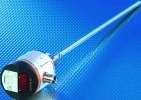IFM's new microwave sensor
September 2006
Sensors & Transducers

The Efector GWR microwave sensor from IFM Electronic is claimed to be the first electronic level sensor for use in small tanks in industrial automation operating on the measuring principle of the guided radar wave. By integrating this technology, tried and tested in the process industry, an economically and technically appealing alternative to the level measurements currently used in machine construction is now possible.
As compared to the currently used systems, the compact microwave sensor features a higher repeatability and it is mainly independent of typical process influences.
The control monitor measures the level using electromagnetic pulses in the nanosecond range. The pulses are transmitted by the sensor head and guided along the probe. When the microwave pulse hits the medium to be detected it is reflected and guided back to the sensor, where it is evaluated.
The sensor is directly mounted in the tank using a G 3/4 process connection or flange plate. If necessary, the sensor rod can be easily shortened and adapted to the tank by the user. Settings of all parameters as well as programming of the switchpoints and indication of the current level are carried out via a 4-digit alphanumeric display.
The Efector GWR is not subject to any mechanical wear and ensures high plant uptime and process safety.
IFM Electronic is represented locally by Shorrock Automation.
Further reading:
Adjustable proximity sensor with five metre range
Sensors & Transducers
The Telco line of photo-electric eyes have the accuracy and reliability you need.
Read more...
Food safety – a matter of weight
Sensors & Transducers
Weighing systems play a key role in ensuring product quality in food production, complying with legal requirements and avoiding product recalls. The Minebea Intec MiNexx portfolio has been specially developed to meet these requirements.
Read more...
Telco sensors in the paper and pulp industry
Sensors & Transducers
The paper and pulp industry poses a major problem for most photoelectric sensors. Telco Sensors has overcome this with its powerful and high-performance photoelectric sensors, ensuring penetration of thick and harsh pollution while guaranteeing reliable detection.
Read more...
Leaders in sensor technology
Sensors & Transducers
A new addition to the Telco Sensors range is the adjustable Proximity sensor, with a range up to 5 metres.
Read more...
Cutting-edge sensor technology
Endress+Hauser South Africa
Sensors & Transducers
The advantage of Endress+Hauser’s Memosens technology is that digitised measured values and sensor information are transmitted via a non-contact connection from the sensor to the cable, and as a digital signal to the transmitter.
Read more...
Miniature inductive sensors
ifm - South Africa
Sensors & Transducers
The inductive IY/IZ type sensors from ifm are used in various industrial areas where space is limited.
Read more...
The expanding role of 3D cameras in industrial quality control
TANDM Technologies
Sensors & Transducers
Across factory floors, warehouses, mines and research centres worldwide, computer vision paired with 3D camera technology is revolutionising quality control.
Read more...
PDS implementation on mines
Sensors & Transducers
Level 9 vehicle intervention for collision avoidance has been mandatory on South African mines since 2022, yet the effective roll-out of proximity detection systems remains slower than expected. This is not due to the technical limitations of integration but to operational readiness on site.
Read more...
Monitoring analogue process values
ifm - South Africa
Sensors & Transducers
Everywhere in industry, electronic sensors are used to detect process values such as temperature, pressure or flow. Process value monitoring often takes place directly in the sensor.
Read more...
Protecting buildings’ embodied carbon with retrofitted systems
Schneider Electric South Africa
Sensors & Transducers
The World Economic Forum has said that around 80% of the buildings in existence will still be around in 2050; it is therefore essential that in order to combat climate change we retrofit them for energy efficiency.
Read more...


